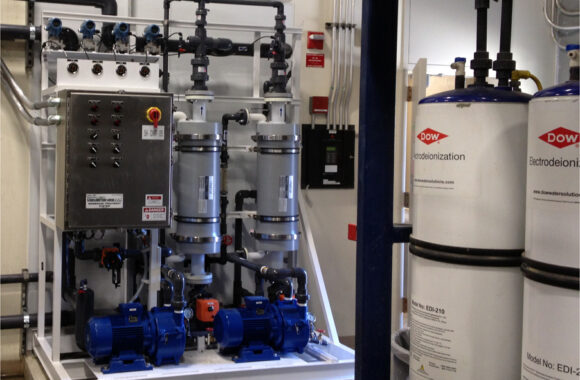Electrodeionization (EDI)
Electrodeionization (EDI)
EDI is a system that can be used instead of a mixed bed resin system to obtain high-purity water (conductivity/EC < 2 µs) after a reverse osmosis system.
Electrodeionization (EDI)
:Description
One of the drawbacks of resin-based systems is the high consumption of chemicals for regeneration and the large space occupied due to the volume of water produced. The EDI system is a combination of ion exchange and membrane filtration processes, which produces salt-free water with an electrical conductivity of less than 2.0 µs/cm. In the EDI system, salts are separated from water through the ion exchange process, with the difference that resins are continuously regenerated by the electric current, eliminating the need for chemicals for resin regeneration. Each EDI unit consists of several cells placed between two electrodes. In each unit, two types of channels exist for the flow:
1- Dilute channel (D): Contains anion and cation resins, functioning similar to a mixed bed resin column. These resins are placed between two types of membranes:
Cation-selective membrane: Designed to allow only cations to pass through.
Anion-selective membrane: Designed to allow only anions to pass through.
The water flows through the dilute channel, and as it passes through the resins and selective membranes, the ions are removed, resulting in purified water.
2-Concentrate channel (C): This channel collects the concentrated stream of ions that have not passed through the selective membranes. It is separated from the dilute channel, ensuring the removal of concentrated ions without contaminating the purified water.
By combining ion exchange and membrane filtration, the EDI system offers continuous and efficient removal of ions from water without the need for chemical regeneration. It provides high-purity water with low electrical conductivity, making it suitable for various applications requiring ultra-pure water.
:Advantages of Electrodeionization (EDI) System over Resin-based Systems
High-purity water is a vital component for production processes in most industries worldwide. Conventional water treatment systems rely on ion removal methods using chemical substances to purify or remove dissolved solids from water. These water deionization systems utilize a bed of mixed ion exchange resins that need to be periodically regenerated through chemical processes. As a result, millions of gallons of chemicals are used daily to produce purified water for industrial applications. The use of these methods not only complicates the operations and increases operational costs but also poses risks associated with chemical regeneration, requiring strict adherence to safety regulations to avoid long-term negative environmental impacts.
Over time, industries have demanded water treatment systems that offer higher water purity, lower costs, and reduced reliance on chemicals, as well as requiring less maintenance and care. An economical approach to producing purified water without the use of chemicals is to combine reverse osmosis and electro-deionization.
:Applications
- Production of ultrapure water in pharmaceutical manufacturing.
- Generation of ultrapure water in laboratories.
- Production of ultrapure water in plating industries.
- Generation of ultrapure water in petrochemical and steel industries.

